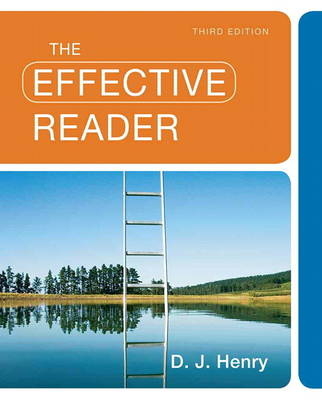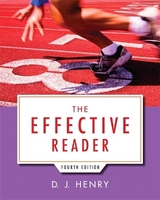
The Effective Reader
Pearson (Verlag)
978-0-205-78088-4 (ISBN)
- Titel erscheint in neuer Auflage
- Artikel merken
Note: This is the standalone book, if want the Book/MyReadingLab order the ISBN listed below:
0205008720 / 9780205008728 Effective Reader, The (with MyReadingLab Pearson eText Student Access Code Card) *
Package consists of
0205752632 / 9780205752638 MyReadingLab with Pearson eText -- Access Card
0205780881 / 9780205780884 Effective Reader, The
Preface
PART ONE Becoming an Effective Reader
Chapter 1 A Reading System for Effective Readers
Prior Knowledge
The Reading Process
Before Reading: Survey and Question
Before Reading
During Reading: Read and Recite
After Reading: Review
After Reading
Textbook Skills: Asking Questions and Reciting Answers Before, During, and After Reading
Applications
Review Tests
Mastery Tests
Chapter 2 Vocabulary and Dictionary Skills
Before Reading About Vocabulary Skills
Words Are Building Blocks
Context Clues: A SAGE Approach
Synonyms
Antonyms
General Context
Examples
Textbook Skills: Using a Glossary
Word Parts
Roots
Prefixes
Suffixes
Reading the Dictionary
How to Read a Dictionary Entry
Spelling and Syllables
Parts of Speech
Definitions
Textbook Aids for Learning Content Words
Textbook Definitions
Textbook Skills: Visual Vocabulary
Applications
Review Tests
After Reading About Vocabulary and Dictionary Skills
Mastery Tests
Chapter 3 Stated Main Ideas
Before Reading About Stated Main Ideas
The Traits of a Main Idea
Identifying the Topic of a Paragraph
Identifying a Topic Sentence
The Flow of Ideas and Placement of Topic Sentences
Topic Sentence at the Beginning of a Paragraph
Topic Sentence Within a Paragraph
Topic Sentence at the End of a Paragraph
Topic Sentence at the Beginning and the End of a Paragraph
The Central Idea and the Thesis Statement
Textbook Skills: Topics, Main Ideas, and Central Ideas in Textbooks
Applications
Review Tests
After Reading About Stated Main Ideas
Mastery Tests
Chapter 4 Implied Main Ideas and Implied Central Ideas
Before Reading About Implied Main Ideas and Implied Central Ideas
What Is an Implied Main Idea?
Using Supporting Details and Thought Patterns to Find Implied Main Ideas
Finding the Implied Main Ideas of Paragraphs
Creating a Summary from the Supporting Details
The Implied Central Idea
Textbook Skills: Graphics as Details That Imply a Main Idea
A Final Note about Experience and Perspective
Applications
Review Tests
After Reading About Implied Main Ideas and Implied Central Ideas
Mastery Tests
Chapter 5 Supporting Details
Before Reading About Supporting Details
Questions for Locating Supporting Details
Major and Minor Details
Creating a Summary from Annotations
Textbook Skills: Chapter-end Questions in a Textbook
Applications
Review Tests
After Reading About Supporting Details
Mastery Tests
Chapter 6 Outlines and Concept Maps
Before Reading About Outlines and Concept Maps
Outlines
Concept Maps
Textbook Skills: The Table of Contents
Applications
Review Tests
After Reading About Outlines and Concept Maps
Mastery Tests
Chapter 7 Transitions and Thought Patterns
Before Reading About Transitions and Thought Patterns
Transition Words: Relationships Within a Sentence
Thought Patterns: Relationships Between Sentences
The Time Order Pattern
The Space Order Pattern
The Listing Pattern
The Classification Pattern
Textbook Skills: Thought Patterns in Textbooks
Applications
Review Tests
After Reading About Transitions and Thought Patterns
Mastery Tests
Chapter 8 More Thought Patterns
Before Reading About More Thought Patterns
The Comparison-and-Contrast Pattern
Comparison
Contrast
Comparison and Contrast
The Cause-and-Effect Pattern
The Generalization-and-Example Pattern
The Definition Pattern
Textbook Skills: Thought Patterns and Textbooks
Applications
Review Tests
After Reading About More Thought Patterns
Mastery Tests
Chapter 9 Fact and Opinion
Before Reading About Fact and Opinion
What Is the Difference Between Fact and Opinion?
Ask Questions to Identify Facts
Note Biased Words to Identify Opinions
Note Qualifiers to Identify Opinions
Think Carefully About Supposed "Facts"
Read Critically: Evaluate Details as Fact or Opinion in Context
Evaluate the Context of the Passage
Evaluate the Context of the Author
Evaluate the Context of the Source
Textbook Skills: Fact and Opinion in Textbook Passages
Applications
Review Tests
After Reading About Fact and Opinion
Mastery Tests
Chapter 10 Tone and Purpose
Before Reading About Tone and Purpose
What Are Tone and Purpose?
Understand How Tone Is Established
Identify Subjective and Objective Tone Words
Discover the General Purpose in the Main Idea
Figure Out the Primary Purpose
Recognize Irony Used for Special Effects
Textbook Skills: Author’s Tone and Purpose
Applications
Review Tests
After Reading About Tone and Purpose
Mastery Tests
Chapter 11 Inferences
Before Reading About Inferences
Inferences: Educated Guesses
What Is a Valid Inference?
Making VALID Inferences and Avoiding Invalid Conclusions
Step 1: Verify and Value the Facts
Step 2: Assess Prior Knowledge
Step 3: Learn from the Text
Step 4. Investigate for Bias
Step 5: Detect Contradictions
Inferences in Creative Expression
Textbook Skills: Inferences and Visual Aids
Applications
Review Tests
After Reading About Inferences
Mastery Tests
Chapter 12 The Basics of Argument
Before Reading About the Basics of Argument
What Is an Argument?
Step 1. Identify the Author’s Claim and Supports
Step 2. Decide Whether the Supports Are Relevant
Step 3. Decide Whether the Supports Are Adequate
Step 4: Check the Argument for Bias
Textbook Skills: The Logic of Argument
Applications
Review Tests
After Reading About the Basics of Argument
Mastery Tests
Chapter 13 Advanced Argument: Persuasive Techniques
Before Reading About Advanced Argument
Biased Arguments
What Is a Fallacy in Logical Thought?
What Is Propaganda?
Irrelevant Arguments: Fallacies
Personal Attack
Straw Man
Begging the Question
Irrelevant Arguments: Propaganda Techniques
Name-Calling
Testimonials
Bandwagon
Plain Folks
Inadequate Arguments: Fallacies
Either-Or
False Comparison
False Cause
Inadequate Arguments: Propaganda Techniques
Card Stacking
Transfer
Glittering Generalities
Textbook Skills: Examining Biased Arguments
Applications
Review Tests
After Reading About Advanced Argument
Mastery Tests
PART TWO Additional Readings
PART THREE Combined-Skills Tests
PART FOUR Reading Enrichment
Appendix Reading Graphics in Textbooks
Chapter Review Cards
Text Credits
Photo Credits
Index
| Erscheint lt. Verlag | 22.11.2010 |
|---|---|
| Sprache | englisch |
| Maße | 187 x 232 mm |
| Gewicht | 1148 g |
| Themenwelt | Schulbuch / Wörterbuch ► Wörterbuch / Fremdsprachen |
| Geisteswissenschaften ► Sprach- / Literaturwissenschaft ► Sprachwissenschaft | |
| ISBN-10 | 0-205-78088-1 / 0205780881 |
| ISBN-13 | 978-0-205-78088-4 / 9780205780884 |
| Zustand | Neuware |
| Haben Sie eine Frage zum Produkt? |
aus dem Bereich



